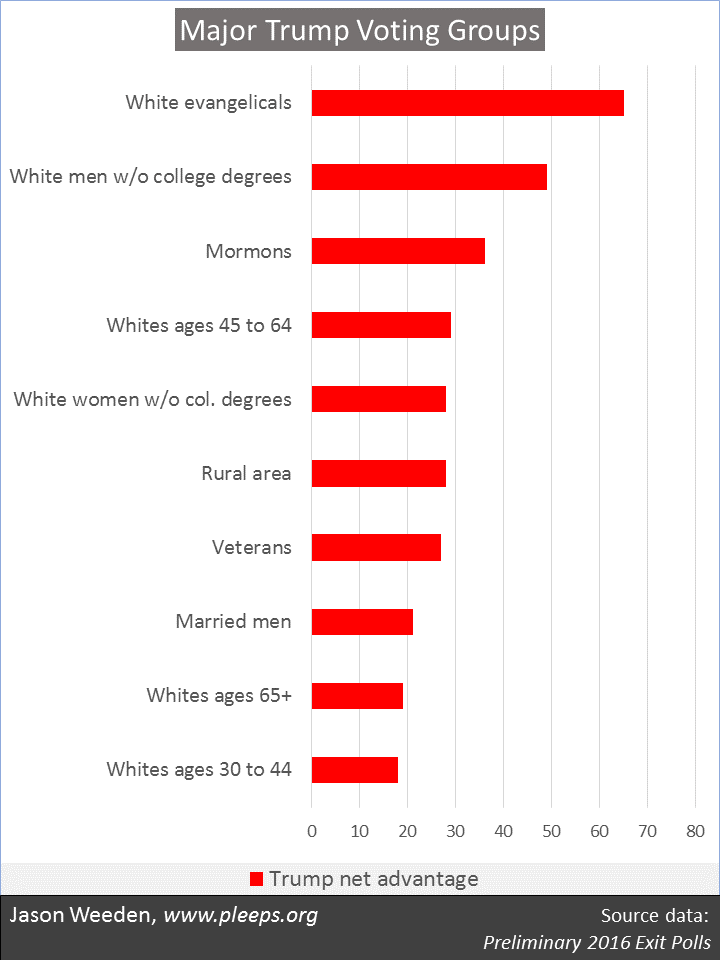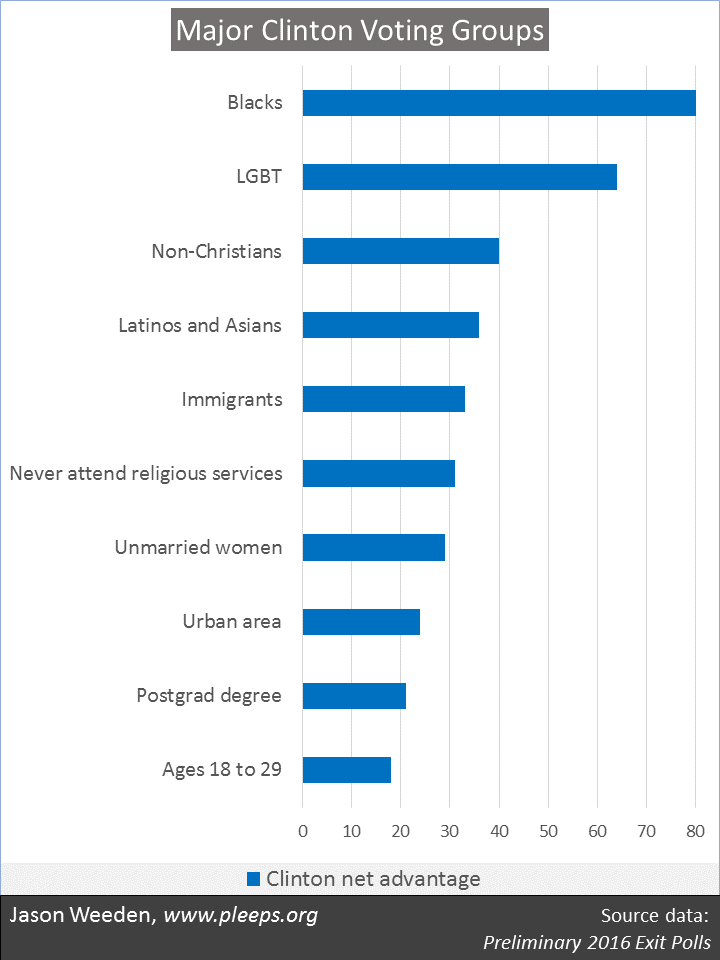So what the hell happened last night? While the 2016 presidential exit polls were conducted in only a limited number of states, and while the full sample has yet to be made public, we can still find clues in the vote margins within various demographic groups.
The chart below contains the major groups that favored Trump. The bars show the Trump-minus-Clinton net exit poll advantage. The Trump coalition primarily included white religious conservatives and whites (especially men) without college degrees. These groups overlap considerably, given that low-education folks are substantially more likely to identify as “evangelical” Christians than high-education folks. But, still, though the exit polls don’t show it directly, it’s safe to assume that, e.g., non-college white men who aren’t Christian were substantially less likely than white evangelicals to support Trump (though they might have still favored him to some degree, something that will take more data to sort out).
The key groups in the Clinton coalition are in the next chart, showing the Clinton-minus-Trump net exit poll advantage. It’s mainly people who worry about various forms of discrimination: Racial minorities, LGBT folks, people who are not Christian, and immigrants. The most-educated folks are here as well, though we don’t yet know what the white vs. non-white breakdown is (though the large majority of people with postgrad degrees are white).
But how does this differ from other recent elections?
The Trump and Clinton voting groups are broadly familiar from other recent elections. It’s been true for a while that white evangelicals and non-college white men tend to support Republicans, and that racial minorities and non-Christians tend to support Democrats. But the exit polls are suggesting that this election had some pretty major shifts.
The big one is white men without college degrees. In 2008, McCain won them by 20 points; Romney increased this margin to 31 points in 2012. And Trump: 49 points. We’ll see if the full exit polls and other data sources confirm a margin in this range. But, if so, that’s most of the answer to how Trump pulled off his upset victory.
Trump also did substantially better than other recent Republicans with groups that are related to non-college white men, including unmarried men (Obama won them by around 18 points in 2008 and 2012, but the current exit polls show Clinton with only a 1 point advantage), people with incomes under $50k (Obama won them by 22 points, while Clinton won them by only 11), and union households (Obama won them by around 19 points, while Clinton won them by only 8).
Clinton picked up a bit of support within certain groups as well, just nothing close to Trump’s gains with non-college white men. The clearest advance was with LGBT folks. Obama won them by 43 in 2008, and then by 54 in 2012. The 2016 exit polls so far show Clinton with a 64 point advantage. Clinton also appears to have made marginal gains with married women. They supported McCain by 4 and Romney by 7, but then Clinton by 2. Then there were some Clinton shifts that were bigger deals comparing 2016 to 2012, but not big deals comparing 2016 to 2008. For example, white women with degrees went for Clinton by 6 after going for Romney by 6 in 2012, yet also went for Obama by 5 in 2008. Similarly, people with incomes above $100k went for Trump by only 1 after favoring Romney by 10 in 2012, yet this group was evenly split in 2008.
Notice that this election appears to have had a substantially weaker—though not eliminated—link between income and party vote. Poorer folks still favored the Democrat while richer folks favored the Republican, but the large 2012 gap was replaced by a much lower 2016 gap. This is due, of course, to Trump’s enhanced performance with non-college whites while Clinton retained non-whites, which scrambled the income-based vote. (I discussed how trends like this might end up changing the long-term party coalitions in the concluding section of a previous post on libertarian demographics.)
So why did we see big shifts with non-college white men? Rob Kurzban and I have a new essay on the Washington Post’s In Theory blog, where we echo some of the findings from our book that are sure to make everyone unhappy: Mainly, these Trump voters have self-interested reasons to favor group-based discrimination, and, finally having been given a candidate who squarely agrees with them, they supported him.


